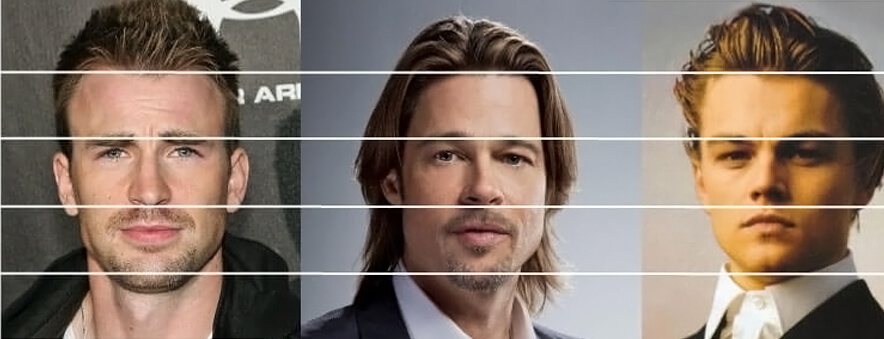Reasons Why Hairline Disappears
• Androgenetic Alopecia, also known as Male Pattern baldness
• Born with a high +/- large forehead
• After surgery
• Skin diseases such Frontal Fibrosing Alopecia, Triangular Alopecia, Alopecia Areata ...
Hairline Design Objectives

Objective 1 : Re-frame the Face
• Your face is like a framed pictures, with the eyes being the focus.
• When you talk, the audience will look at your eyes to show interest and attention.
• With receded hairline, the upper frame is lost.
• Eye contact will unintentionally shift to your empty forehead - quite an embarrassment for both!
• The first priority in hair transplant is therefore to re-frame the faces so that eyes of audience are not drawn toward.
Objective 2 : Re-establish Lost Aesthetic Balance
• All the facial features such as eyes, nose, hairline, lips, are related to each other in proportions
• Dr. Marquardt quantified beauty scientifically by developing the "Perfect Face" Mask based on the Phi ratio 1 : 1.618
• The closer various facial features such as length of nose, position of eyes and length of chin correlate to this mask, the more aesthetically pleasing the face is
• This mask has been widely used in cosmetic surgery
• Hairline provides a complementary balance to the other facial structures
• Hair transplant can re-establish the aesthetic balance that was lost in the balding process
Objective 3 : Create Age-Appropriate or Younger Look
• The loss of hair is associated with old age.
• The apparent loss of vital energy adversely affects employment and social interaction.
• By restoring a hairline and adding on hair to bald scalp, an age-appropriate or even younger look can be achieved.
Objective 4 : Increase Facial Attractiveness
We judge by pattern recognition. The followings are basic criteria for facial attractiveness. If any one of these features is disturbed, the face will be distorted losing its attractiveness. By properly designing a hairline the following can be restored:
• Symmetry
• Balance
• Proportion
The Phi Rule
The Phi rule, also known as the Golden Ratio, is a mathematical principle that has been used to define beauty in terms of proportion and balance. In facial aesthetics, the Phi rule can be applied by measuring the ratios of various facial elements and ensuring they align closely with the golden ratio of 1.618. For example, the ideal facial structure might include the following based on the Phi rule:
1. Width of the Face: The width of the face at the level of the eyes should ideally be about 1.618 times the width of the mouth.
2. Position of the Eyes: The distance between the eyes should ideally be 1.618 times the width of an eye.
3. Length of the Face: The length of the face from the top of the forehead to the bottom of the chin divided into three equal parts (forehead to eyebrow, eyebrow to base of the nose, and base of the nose to chin) should ideally follow the golden ratio.
These proportions are considered universally appealing and are used by plastic surgeons and dermatologists to guide cosmetic treatments and procedures, aiming to bring facial features closer to these ideal ratios. This mathematical approach is believed to enhance facial harmony and attractiveness by aligning facial features with these aesthetically pleasing and naturally occurring proportions.
Da Vinci's Golden Rule of Thirds

In Western countries the proportion of beauty is Da Vinci's Golden Rule of Third.
In hairline design the Anterior-most point is set according to this rule. An ideal face should have equal vertical distance from:
• Lower 1/3 - Lowest point of hairline to Glabella
• Middle 1/3 - Glabella to base of nose
• Upper 1/3 - Base of nose to tip of chin
Violation of the Golden Rule in Asians
From our observation not everyone fits into this rule, especially the Asians. The 3 facial parts as mentioned do not have to be exactly equal to look good. There are still some rules regarding their proportion if to look good.
Example 1 : Smaller chin
• Most Chinese and some Caucasians have a smaller chin.
• A small chin gives an elegant and gentleman look.
• The hairline has to set lower accordingly.
Example 2 : Longer chin
• This type is seen mainly in the Caucasians
• Long chin induces a sporty and adventurous charactesr.
• The hairline has to be set higher accordingly.
Our New Golden Rule
• We have studies hundreds of pictures of "attractive" celebrities.
• After checking and comparing their facial proportions, we have developed a new Golden Rule.
• The result of our study, "the New Landmarks in Hairline Design", was presented in the ISHRS Annual Scientific Meeting (2009 Amsterdam, Netherland).
Men - Hairline Restore Considerations
Men Receding Hairline - the 4 Patterns
1. M Shaped - Receding Apex

2. Receding Hairline with Retained Forelock

3. Inverted U

4. Losing the Temporal Hairline As Well

Four Basic Rules in Hairline Design
There are 4 Other Rules for Designing an Attractive Hairline in Men
• The apex is directly above the outer corner of the eye
• The apex is not rounded
• Hairline when looked at from front is an inverted U
• Hairline when looked at from side is horizontal
Overall satisfactory rate is above 90% after restoring the empty areas with hair transplant. The number of follicular units required will br governed by the area and the density desired. When planned wisely, just 1,800 t0 2,400 grafts can achieve quite reasonable visual improvement. For those demanding a ver dense look, a second procedure mat be required for touch up. Usually in the second procedure the receded temporal hairlines on both sides are also repaired.
Common Mistakes In Men Hairline Restore - the Kappa
河童 or "river-child" are legendary creatures, a type of water sprite found in Japanese folklore.
Kappa are typically depicted as roughly humanoid in form, and about the size of a child. Their most notable feature is an indentation on the top of their head that holds water; this is regarded as the source of their power. This cavity must be full whenever a kappa is away from the water; if it spills, the kappa will be unable to move (source of information)。
We recommend not to set the hairline too low, especially in young adults. There is always a risk of progressive hair loss extending to the crown. If the patient do not have adequate donor hair to cover the extensive bald area, they will end up with a rim of hair in the front, the appearance of a Kappa.
The primary aim of hair transplant is to good good, not just the transfer of hair from one region to another. Hair tansplant has gained popularity in the last few years. Consequently we are facing with an increasing demand for repairing work. Many patients are not happy with their previous transplant, and want us to do something.


Real Failed Cases and How We Fix It
河童 or "river-child" are legendary creatures, a type of water sprite found in Japanese folklore.
Kappa are typically depicted as roughly humanoid in form, and about the size of a child. Their most notable feature is an indentation on the top of their head that holds water; this is regarded as the source of their power. This cavity must be full whenever a kappa is away from the water; if it spills, the kappa will be unable to move (source of information)。
We recommend not to set the hairline too low, especially in young adults. There is always a risk of progressive hair loss extending to the crown. If the patient do not have adequate donor hair to cover the extensive bald area, they will end up with a rim of hair in the front, the appearance of a Kappa.
The primary aim of hair transplant is to good good, not just the transfer of hair from one region to another. Hair tansplant has gained popularity in the last few years. Consequently we are facing with an increasing demand for repairing work. Many patients are not happy with their previous transplant, and want us to do something.


Unfortunately correcting a poorly placed hairline is always impossible. The only remedy is to do it right in the first place. Here we have some of these examples referred to our center for repair.

Example 1 : Position of the hairline was reasonable, but the density was too low. Also the hairline was too rigid and orderly to be natural
Remedy: Randomly add on density in front of and amongst the existing hairs

Example 2 : The new apex was too rounded. The transplanted hairs did not match the existing ones in angles and directions.
Remedy: Punch out the unwanted transplanted hairs and recycled, will leave scars

Example 3 : Not enough grafts to fill in the center behind the hairline, creating the look of a Kappa
Remedy: Simply add on the density

Example 4 : There was inadequate density of grafts behind the narrow hairline.
Remedy: Add more grafts in the empty area.

Example 5 : Asymmetry in the hairline - the right side is higher than the left by 2cm.
Remedy: Lower the right side by 1cm may improve.

Example 6 : Difficult to style the hair as the grafts were inserted perpendicularly. Correct angle should be 35-45°.
Remedy: No!

Example 7 : The typical 'Corn Rows" appearance, when minigrafts instead of follicular units were used. The insertion was too orderly.
Remedy : Put some 1-hair FU in front, and add more grafts in between.

Example 8 : Another typical example of the "Corn Rows" appearance. The pattern is more obvious on cutting short the hair.
Remedy : Add grafts in between inorderly to be more natural looking.


